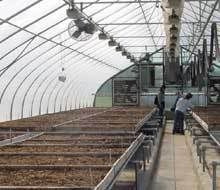The idea of hydroponic gardening (gardening without soil), has been
around since the time of King Solomon. There are a few advantages with
hydroponic gardening over traditional gardening -for example the rate of
growth of a hydroponic plant can be up to 50% faster than a soil plant
grown under the same conditions.
And the yield of the plant is also
greater!
The reason for this is that the plants get
their nutrition fed directly into their roots from nutrient rich water.
Since this water is so high in nutrient content, the plant does not need
large roots to search for nutrition. And since the plant expends less
energy in growing roots it has more energy available to be productive
above the rootline! Hydroponically grown vegetables are healthy,
vigorous, and consistently reliable. This form of gardening is clean and
extremely easy, and it requires very little effort.
Hydroponic
gardening is also beneficial to the environment. For example hydroponic
gardening uses considerably less water than soil gardening because of
the constant reuse of the nutrient solutions. And also, fewer pesticides
are necessary in hydroponic crops -they are not as necessary. And
topsoil erosion is not even an issue since hydroponic gardening systems
use no topsoil.
How exactly does a hydroponically grown plant get
its nutrition -nutrition it normally gets from the soil? Well, these
nutrients come in liquid or powdered mixes and can be purchased at a
hydroponic supply store. And like soil, hydroponic systems can be
fertilized with organic or chemical nutrients. But you should know that
an organic hydroponic system can be considerably more work to maintain
since the organic compounds have a tendency clump.
Hydroponic
systems are normally categorized as passive or active. An active
hydroponic system moves the nutrient solution with a pump. A passive
hydroponic system relies on the capillary action of the growing medium
or a wick.
In a passive system the nutrient rich solution is
absorbed by the medium or the wick and passed along to the plant's
roots. But a downside with this method is that they are usually too wet
and do not supply enough oxygen to the root system for the best growth
rates.
Hydroponic systems are also characterized as recovery or
non-recovery. In recovery systems, the nutrient solution is
re-circulated for reuse. In a non-recovery system however, the nutrient
solution is not recovered.
You may be unsure of whether to buy or
build a hydroponic system. If you have an 'engineering mind' and want
to build one, consider buying one first just to get familiar with the
inner workings. Buy a system which does not cost a lot of money. It will
give you a better understanding of how hydroponics works and the
hands-on experience can be worth the cost of the system as you will be
able to reuse the parts when you decide to build one.
Hydroponics
gardening is a popular and growing hobby and many are finding this to
be fun, exciting, and easy to get started.
By Tony Buel